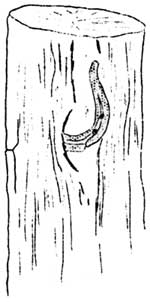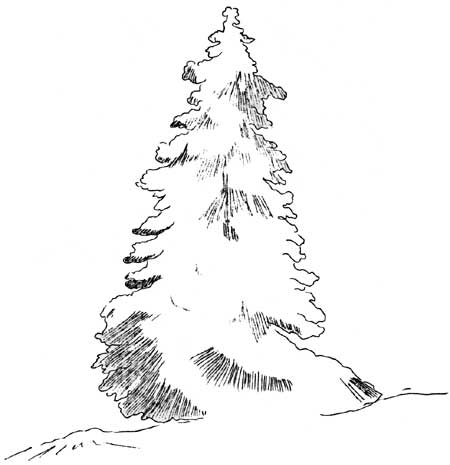
At this time of the year the trees are waking from their winter's
rest and sending out their new leaves and blossoms. Perhaps you have
wondered just what has happened. How can all this take place so quickly
in the warm days of early spring? You may also be curious about other
tree doings. Is it true that buds keep the young leaves warm during the
winter? Do trees grow as children grow, or in a quite different way?
What makes the grain in wood and what causes knot-holes?
When I say that more leaves fall from trees in the spring than in the
autumn, it sounds rather dubious. Let me explain what I mean. Suppose we
take a twig and look at a bud. Each bud is covered with many flat
bud-scales, which protect the inner parts. The scales are really tiny
leaves which are different in shape and color from the ordinary leaves.
They fall off soon after the bud opens, so more leaves fall in the
spring. During the winter the scales are wrapped tightly around the bud,
and many people suppose they keep the bud warm. This is not the case,
for the moisture within the bud freezes, forming small ice crystals. You
could not keep a fence post warm in winter by dressing it in an
overcoat. Our coats warm us by holding in the heat of the body, but the
fence post and the bud do not make their own heat. The function of bud
scales is to keep the bud from drying out. It must retain its moisture
in order to stay alive. Freezing during its winter resting season is not
likely to kill it, but of course after growth starts again the young
leaves may be killed by frost.
When a bud grows in spring it gives rise to a new twig. This twig may
bear either loaves or flowers alone, or both together. A plum tree has
two different kinds of buds, one containing leaves, the other flowers.
But an apple tree sends forth both leaves and blossoms from the same
bud.
The buds that we see opening this spring are nearly a year old. They
were first formed last May or June, grew larger during last summer, and
rested all winter. Sometimes buds don't wait over winter, but open
abnormally in the fall of their first season. Hence looking closely into
a winter bud, we can see the young leaves or flowers already formed, and
folded very compactly to fit in the small space.
In the warm spring weather they take up water, the young twig grows
longer, pushes apart the bud scales, and the leaves and flowers unfold.
After the first swelling of the flower bud it may be only a couple of
days before the flowers are fully opened. Such a tree is the red maple,
and the willows here in the park are a close second in speed of
flowering.

HORSESHOE TREE in the Park Museum, Longmire. |
But what was inside the bud before the leaves and flowers were formed
in it last summer? Now a tree is made up entirely of little units called
cells, which are like tiny wooden boxes, too small to be seen without a
microscope. Most of the cells in a tree are dead and their walls are
hard and rigid so that the tree can stand upright. They make up the wood
of a tree. But the cells within a bud are soft and delicate, for they
are alive and able to grow. A group of these cells is called a growing
point. This is the most important part of every bud. When its cells grow
and multiply in number they build up the young twig, leaves, and flowers
with the new cells that they make. Yet the growing point itself goes on
as such indefinitely, always alive. When it grows it builds up other
parts of the twig behind it, so that it keeps moving upward as the twig
gets longer. This is the secret of how trees grow taller. It may be
compared to a bricklayer building a tall factory chimney. He himself
stays on top of it all the time, and the more bricks he puts in place
the higher he is raised above the ground. The bricklayer stands for the
growing point, the chimney for the twig and the bricks for its cells. As
the twig grows taller the growing point at its tip is pushed continually
higher. Isn't it remarkable that a huge Douglas Fir two hundred feet
high owes its entire height to the work of a tiny cluster of cells at
the very end of its topmost twig?
Yes, you say, but how about the thickness of that massive Fir trunk.
Surely that was not formed by the growing points at the ends of the
twigs. Quite right. These growing points supply only a foundation by
furnishing the growth in height, and in thickness equal only to the
thickness of a year-old twig, or about a quarter inch. All the rest of
the diameter of a tree is built by a different region of growth, called
the cambium layer. This is a very thin sheet of living, growing cells
located between the bark and the wood. The cambium is actually only a
single cell in thickness, but it extends all over the tree almost to the
tips of the twigs. When these cambium cells grow and multiply, the new
cells they form toward the outside become bark, while those toward the
inside become wood. The cambium is forced to move farther and farther
outward by the wood thus formed inside it. Practically all of the wood
of a tree is made in this way. What a debt our lumber industry owes the
cambium layer.
Everyone has noticed the circular lines on the cut end of a log or
stump. Each of these rings shows the amount of wood grown in a single
year of the tree's life, hence it is known as an annual ring. Though it
looks like a ring in a cut across the tree, it is clear that it is
really a thin continuous layer of wood reaching all over the tree. Each
layer is distinct because the cambium lays down larger cells in the
springtime, and more of them. This makes an abrupt line where the wood
stopped growth at the end of one season, and started rapid growth the
following spring. The difference in appearance between spring and summer
wood gives wood its characteristic grain. The cambium, then, adds a new
coat of wood every year to the outside of all the wood already there. In
this way a tree gets bigger around year by year. Imagine what would have
happened to old Rip van Winkle if he had lain down snugly between two
trees for his twenty-year nap.
Now suppose that ten years ago you drove a spike into a tree four
feet above the ground, where would it be today? Provided the ground had
stayed put, the spike would still be four feet above it, because the
tree grows taller only at the tips of the twigs, not by pushing up from
under ground like a sprouting bean. But the tree might have grown out
around the spike and buried it, unless it had been left sticking out an
inch or more originally. A horse shoe that was fastened to a tree by the
Longmires in the early days here was found nearly covered over, and is
in the Park Museum at Longmire. Knots in a board are branches of the
tree which have been buried at their base by this growth in thickness of
the trunk. If the branch was living when it was being covered up, the
knot will be very tightly fastened in the board. This is because a
continuous layer of wood was formed each year over the trunk and all
living branches, knitting the branches tightly to the trunk. But if the
branch was dead the trunk will merely grow out around it just as it
surrounded our spike. Then if the tree is sawed into boards you. will be
able to punch the piece of branch out of the board, leaving a smooth,
round knot-hole.
To summarize, a tree grows very differently from the way a child
grows. The child grows clear through, both in height and thickness. If
he grew like a tree only the top of his head and the tips of his fingers
and toes would grow to increase his height, while a thin layer just
under his skin would be responsible for making him bigger around.
Alton A. Lindsey,
Ranger-Naturalist.


